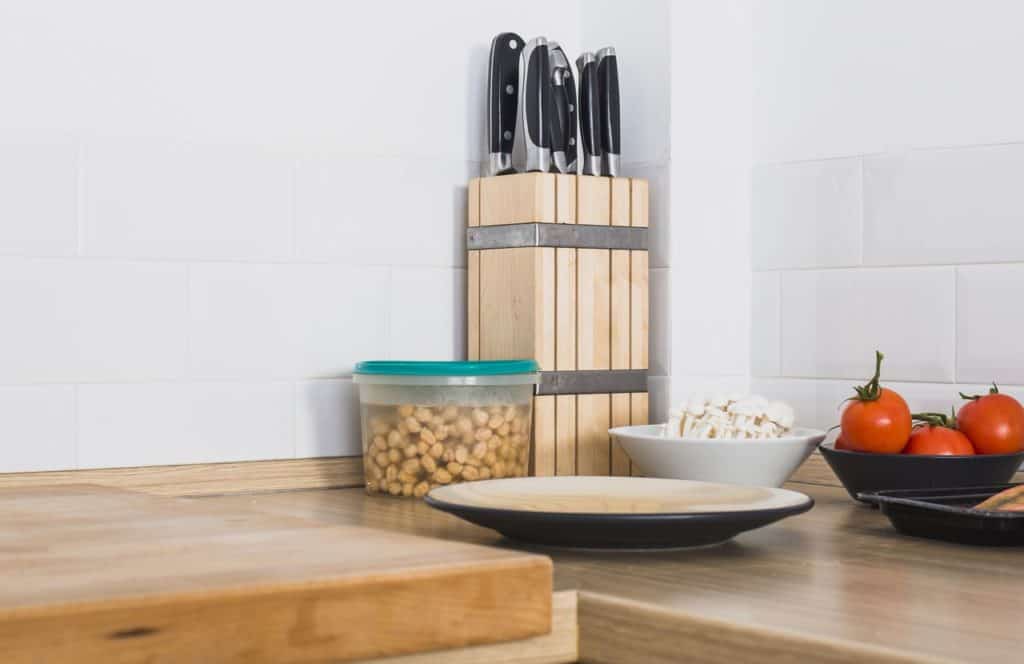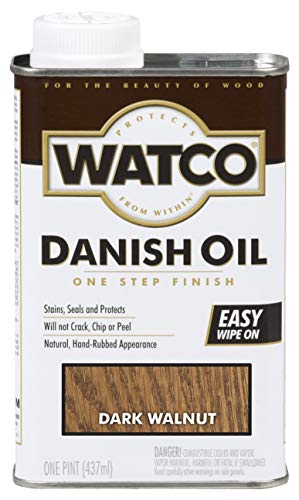One of the uses of Danish oil is to give furniture its final look and enhance its appearance. This wood oil gives furniture a beautiful finishing touch.
But did you know it also helps add sheen to kitchen utilities like plates, chopping boards, kitchen cupboards, and salad bowls?
Many people wonder if using this oil to give finishing touches to their kitchen products is a good idea. And more importantly, is danish oil food safe?
In case you are also wondering about this, here is everything you need to know.
Is Danish Oil Food Safe?
Yes, Danish oil is food safe. Danish Oil dries to a tough, long-lasting finish when applied to wood. Direct food contact with the oil in its liquid state is not ideal. However, once it’s completely dry, it’s absolutely fine.
What Is Danish Oil Made Of?
Danish oil is usually created from a combination of Linseed and/or Tung oil. To make the wood durable and easy to work with, producers add ingredients like mineral spirit, synthetic resins, and varnish to Danish oil.
There is no standard recipe for making this oil finish for wood, so the content may differ across producers.
Unsafe Chemical Substances
Varnish
Varnish gives wooden surfaces a glossy look. You may find the glossy look on the furniture soothing, but consuming varnish is dangerous to humans. It can cause symptoms like headaches, dizziness, drowsiness, and skin irritation.
If a person consumes high concentrations of varnish, they may suffer respiratory problems and can even develop pulmonary edema.
Turpentine
Turpentine can cause different problems and symptoms depending on how long you have been exposed to it.
If the exposure was short-term, it can irritate the eyes, nose, throat, and lungs. Long-term exposure to turpentine can cause skin irritation and skin sensitivity.
Mineral Spirit
Mineral spirit is a type of thinner and a paint solvent. Even though mineral spirits have a low order of acute toxicity, they can remove protective skin oils. This may cause rash or dermatitis.
It can aspire into the lungs and cause respiratory irritation or pulmonary edema if swallowed.
Synthetic Resins
Used primarily in decor and jewelry, synthetic resins can trigger allergic reactions in people with a weak immune system. They can also cause respiratory irritation when inhaled for an extended period.
Is Danish Oil Food Safe For Cutting Boards?
Yes, Danish oil is completely food safe for a cutting board. Danish oil is naturally water-resistant, food-safe, and alcohol-resistant. Thanks to these qualities, you can safely use it to varnish cutting boards and other wood kitchen utensils.
When dried, danish-oil coated wooden bowls are completely safe. You can also cut vegetables, fruits, and meat on Danish oil pine coated cutting boards and butcher’s blocks.
Is Danish Oil Toxic?
No, when used properly, danish oil is not toxic. While it is in its liquid state, it can be toxic to inhale or ingest. But once it has dried completely and taken on a durable and hard-wearing finish, it is safe.
Try to avoid repeated or prolonged contact with the product. It can remove natural fats from the skin, resulting in non-allergic contact dermatitis.
Related read: Is polycrylic toxic?
Can You Use Danish Oil on a Cheeseboard?
Yes, you can use Danish oil on a cheeseboard. The oil gives it a more stable finish and rubs out a nice luster.
First, wipe off the cheese board clean, apply the oil, and let it sit for 3 to 5 minutes. Wipe it off completely, then repeat it 2 or 3 times until you still see the sheen after the oil has dried.
Is Watco Danish Oil Safe for Cutting Boards?
Yes, the Watco danish oil is safe for cutting boards. As mentioned earlier, danish oil is safe unless inhaled or ingested in a liquid form.
Watco Danish oil has been used for cutting boards for years and is completely safe if you let it dry first.
Food Safe Danish Oil
By penetrating deep into wood pores, danish oil preserves the wood from the inside while enhancing the appearance and feel on the outside.
The result is a warm glow, a rich typical hand-rubbed finish. Considering its water resistance, this oil is the best finishing product to use on kitchen products.
If you want to try it yourself, here are our top three Danish Oils products:
1. Watco 65851 Danish Oil Wood Finish, Pint, Dark Walnut
- Ideal for use on a variety of indoor wood surfaces including bare, stripped or sanded; not recommended for floors
- Oil-based formula of blended oil & varnish penetrates deeply into wood pores for ultimate protection
- Dries to the touch in as little as 6 hours and covers up to 85 sq ft
The oil-based formula in this wood finish goes deep into the pores of the wood. It gives your furniture ultimate protection. Within 6 hours, the oil is dry to the touch and covers up to 85 square feet.
You can apply the paint to bare, stripped, and sanded surfaces of wood inside, but don’t use it on floors.
The pint dark walnut oil finish by Watco creates a rich and warm glow with a hand-rubbed appearance. It protects furniture against spills, abrasion, and clipping. You can also use the oil on bare or stripped and sanded wood.
2. Watco Danish Oil Wood Finish, Low VOC, Pint, Natural
- Ideal for use on a variety of indoor wood surfaces including bare, stripped or sanded; not recommended for floors
- Low VOC, oil-based formula of blended oil & varnish penetrates deeply into wood pores for ultimate protection
- Dries to the touch in as little as 6 hours and covers up to 85 sq ft
The beautiful clear tone makes this oil ideal for use on a variety of indoor wood surfaces. You can use them on bare, stripped, or sanded surfaces but not on the floor.
Its low VOC, oil-based formula penetrates deep into the wood. It protects it inside while giving it a beautiful and glossy appearance outside.
The oil takes around 6 hours to completely dry. It can cover an area of 85 sq ft. It is easy to apply and protects your beautiful furniture from spills and abrasions.
3. Rust-Oleum A65841 Watco Danish Oil Wood Finish for Interiors
This wood stain color oil is a unique blend of penetrating oil. The varnish present in the oil will harden the inside as well as the outside of the wood. Again, like any other danish oil, you should only use this indoors.
You get stain, seals, and protection in one easy step with this oil. You can use it to prevent your wood from cracking, chipping, or peeling. Apply it on interior wood surfaces like cabins, furniture, and doors.
Alternatives To Danish Oil
Alternative oil products such as Teak and Tung oil offer sheen, strength, and look similar to Danish oil.
Take some time to review the various Danish oil advantages and disadvantages before deciding on what product works best for you. With proper research, you can find an alternative to Danish oil with less hassle and easier application procedures.
For Drying Oils:
Pure Tung Oil
You can use tung oil to preserve wood. Woodworkers achieve hand-rubbed finishes with this product. You can use this oil for wood furniture, boat decks, flooring, unfinished wood, and aged wood.
Additionally, pure tung oil food-safe finish can be used on concrete floors, worktops, stone, bamboo, brick, cabinets, musical instruments, and wooden toys.
Raw Linseed Oil
The oil extracted from flax seeds is possibly one of the most beneficial oils. Linseed oil on deck is also a preservative. It is also an ingredient in paint, varnish, and stains. It is also used in the manufacturing of soaps, inks, and linoleum!
Read: Danish Oil Vs Linseed Oil
Walnut Oil
The walnut oil hardens into a food-safe, satin finish when it is completely dry. This makes it perfect for bowls, butcher blocks, and cutlery.
As it’s a slow-drying oil, it’ll cure more quickly in a warmer environment, so you should keep it at room temperature rather than in the sun.
Read also: Is boiled linseed oil food safe?
For Non-Drying Oil:
Fractionated Pure Coconut Oil
Fractionated pure coconut oil can moisturize hardwood cutting boards, helping to prevent deterioration over time. And don’t worry, it won’t impart a coconut taste to your food.
When combined with the best glue for cutting boards, you can ensure your cutting board remains both well-maintained and structurally sound for years to come.
Coconut oil fractions will hydrate your wood. This will make it less susceptible to water and stains. It will also prevent microorganisms from growing.
Food Grade Mineral Oil
If you find mineral oil labeled with a food-grade seal, it means that it is free of harmful contaminants. The oil assists in preserving the water-repellent quality of cutting boards and as a lubricant on food machines.
As this oil may cause respiratory problems, eating or cooking with it is very unsafe.
Read: Food Safe Wood Stain And Sealer
Conclusion
The bottom line is that Danish oil is safe for food. However, you will need to let it completely dry every time you use it.
This means you should not touch the surface where the oil was applied for a minimum of 6 hours. Keep a strict eye on your children and pets in the house as it is especially dangerous for them.
Many people are concerned that their children or pets will lick the surface, for good reason. Ensure your kids do not play near the surface, keep an eye on them, and never leave them unsupervised in the area.
What next? Read our article “Is there a food-safe polyurethane” to get informed about suitable finishes for culinary applications.




